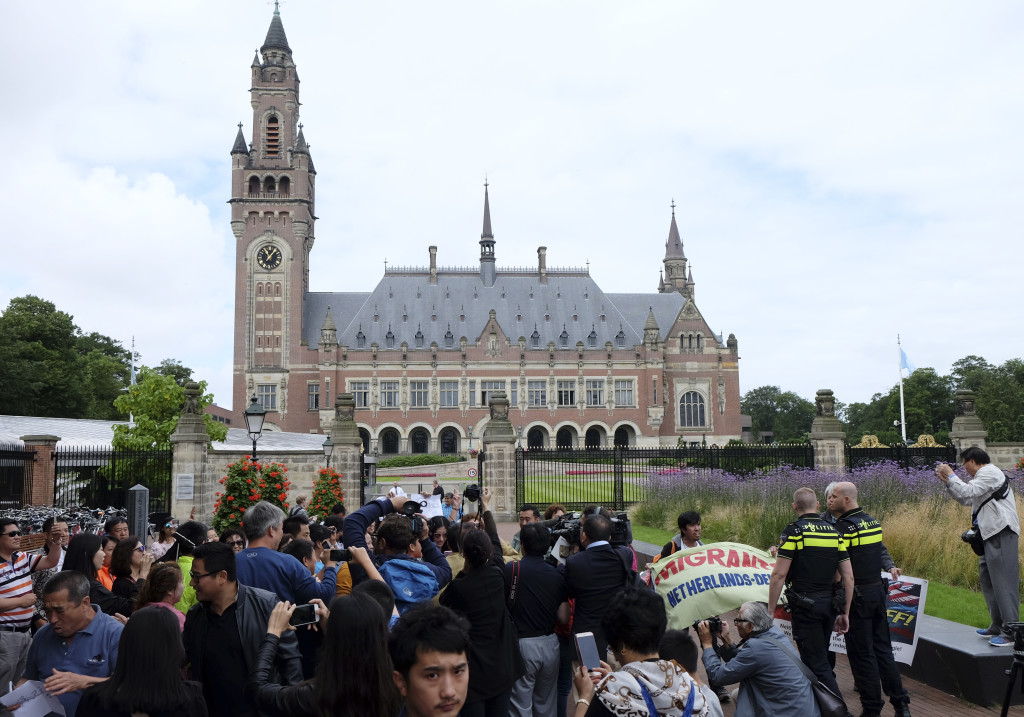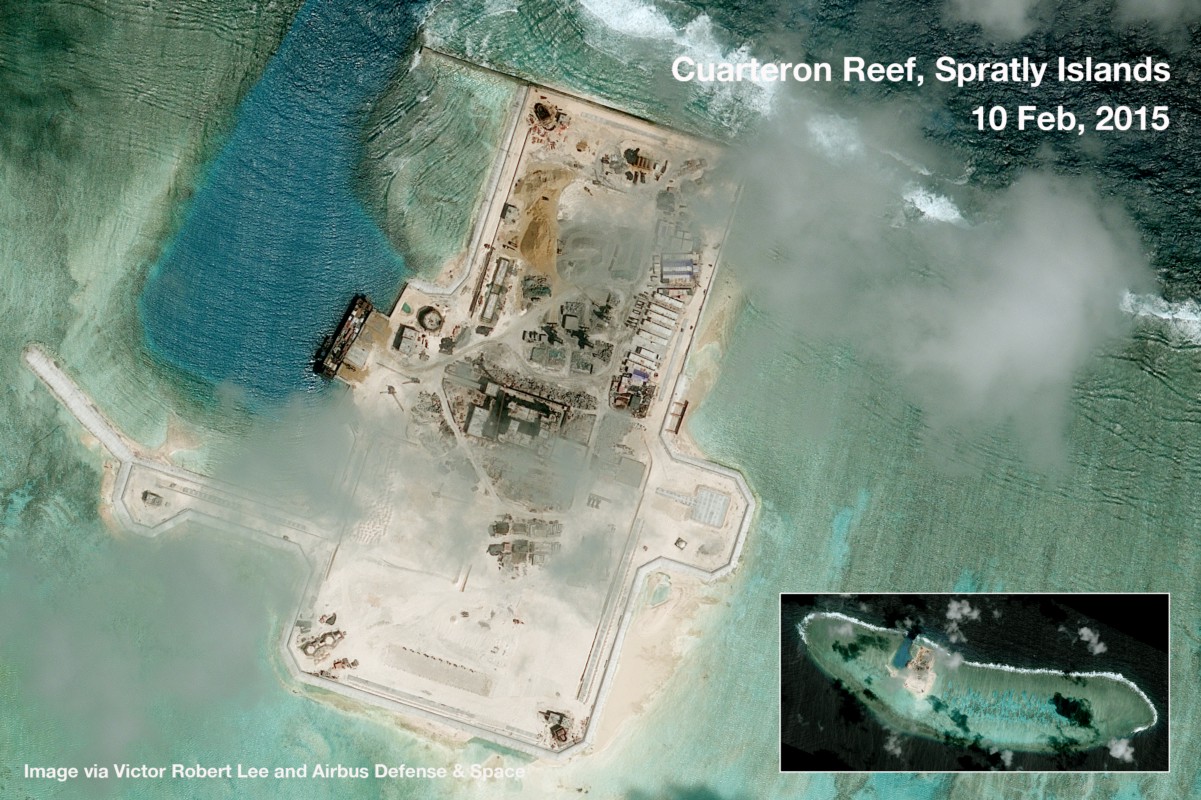Key points of arbitral tribunal’s verdict on PH-China dispute

Demonstrators, police, and media gather outside the Peace Palace in The Hague, Netherlands, on Tuesday, July 12, 2016, ahead of a ruling by the Permanent Court of Arbitration (PCA) on the dispute between China and the Philippines over the South China Sea. China has intensified the drumbeat of its opposition to an international tribunal’s ruling expected Tuesday that could threaten its expansive claims in the South China Sea. (AP Photo/Mike Corder)
The international Arbitral Tribunal on Tuesday issued its award on the arbitration case between Philippines and China over the West Philippine Sea (South China Sea) dispute.
BACKSTORY: Philippines wins arbitration case vs. China over South China Sea
In a 501-page award, the Tribunal decided in favor of the Philippines and said that China does not have historic rights to the South China Sea and that their “nine-dash line” claim has no legal basis.
READ: Key points of arbitral tribunal’s verdict on PH-China dispute
Below are five key points included in the summary statement released to the media
Article continues after this advertisement(1)Historic Rights and the ‘Nine-Dash Line’:
The Tribunal concluded that, to the extent China had historic rights to resources in the waters of the South China Sea, such rights were extinguished to the extent they were incompatible with the exclusive economic zones provided for in the Convention.
Article continues after this advertisementThe Tribunal also noted that, although 2 Chinese navigators and fishermen, as well as those of other States, had historically made use of the islands in the South China Sea, there was no evidence that China had historically exercised exclusive control over the waters or their resources.
The Tribunal concluded that there was no legal basis for China to claim historic rights to resources within the sea areas falling within the ‘nine-dash line’.
(2)Status of Features:
The Tribunal noted that the reefs have been heavily modified by land reclamation and construction, recalled that the Convention classifies features on their natural condition, and relied on historical materials in evaluating the features.
The Tribunal found historical evidence to be more relevant and noted that the Spratly Islands were historically used by small groups of fishermen and that several Japanese fishing and guano mining enterprises were attempted.
The Tribunal concluded that such transient use does not constitute inhabitation by a stable community and that all of the historical economic activity had been extractive. Accordingly, the Tribunal concluded that none of the Spratly Islands is capable of generating extended maritime zones.
The Tribunal also held that the Spratly Islands cannot generate maritime zones collectively as a unit. Having found that none of the features claimed by China was capable of generating an exclusive economic zone, the Tribunal found that it could—without delimiting a boundary—declare that certain sea areas are within the exclusive economic zone of the Philippines, because those areas are not overlapped by any possible entitlement of China.
(3)Lawfulness of Chinese Actions:
Having found that certain areas are within the exclusive economic zone of the Philippines, the Tribunal found that China had violated the Philippines’ sovereign rights in its exclusive economic zone by (a) interfering with Philippine fishing and petroleum exploration, (b) constructing artificial islands and (c) failing to prevent Chinese fishermen from fishing in the zone.
The Tribunal also held that fishermen from the Philippines (like those from China) had traditional fishing rights at Scarborough Shoal and that China had interfered with these rights in restricting access.
The Tribunal further held that Chinese law enforcement vessels had unlawfully created a serious risk of collision when they physically obstructed Philippine vessels.
(4)Harm to Marine Environment:
The Tribunal considered the effect on the marine environment of China’s recent large-scale land reclamation and construction of artificial islands at seven features in the Spratly Islands and found that China had caused severe harm to the coral reef environment and violated its obligation to preserve and protect fragile ecosystems and the habitat of depleted, threatened, or endangered species.
The Tribunal also found that Chinese authorities were aware that Chinese fishermen have harvested endangered sea turtles, coral, and giant clams on a substantial scale in the South China Sea (using methods that inflict severe damage on the coral reef environment) and had not fulfilled their obligations to stop such activities
(5)Aggravation of Dispute:
Finally, the Tribunal considered whether China’s actions since the commencement of the arbitration had aggravated the dispute between the Parties.
The Tribunal found that it lacked jurisdiction to consider the implications of a stand-off between Philippine marines and Chinese naval and law enforcement vessels at Second Thomas Shoal, holding that this dispute involved military activities and was therefore excluded from compulsory settlement.
The Tribunal found, however, that China’s recent large-scale land reclamation and construction of artificial islands was incompatible with the obligations on a State during dispute resolution proceedings, insofar as China has inflicted irreparable harm to the marine environment, built a large artificial island in the Philippines’ exclusive economic zone, and destroyed evidence of the natural condition of features in the South China Sea that formed part of the Parties’ dispute.
BACKSTORY: #InquirerSeven FAQ about the Philippines vs. China arbitration case
The Convention
Under the United Nations Convention on the Law of the Sea (UNCLOS) a coastal state needs to have land before they can claim rights to the sea. The international treaty has been signed and ratified by both the Philippines and China.
“You need to have land before you can have rights to the sea. It’s as simple as that.You cannot just have rights to the sea without owning land,” former Solicitor General Francis Jardeleza said in a forum at the University of the Philippines (UP) Law Center in 2014, citing the basic principle of UNCLOS.
China asserts it has “indisputable sovereignty” and “historic rights” to over two-thirds of the 3.5 million square kilometers South China Sea using its “nine-dash line” claim that overlaps with the UNCLOS-mandated 200-nautical-mile Exclusive Economic Zone (EEZ).
The line, encircling an area roughly the size of Mexico, overlaps territories claimed by the Philippines, Vietnam, Malaysia, Brunei and Taiwan. China argues that its historic rights justify the line. But the Philippines insists that these rights cannot be used to define sea borders.
The Philippines says since the South China Sea is mostly sea, there is no land mass or clumps of islands and rocks there large enough to generate sea borders that will span the over 2 million square kilometers China is claiming with its nine-dash line.
In recent months, China has conducted massive land reclamation activities turning submerged reefs into artificial islands capable of hosting military equipment and structures.
Unclos, however, does not recognize artificial islands and states that these are not entitled to a 12 nautical mile territorial sea nor a 200 nm eez.
PHOTOS: China’s construction of military bases in Spratlys
/rga
RELATED STORIES:
China: We are the victims in dispute; won’t heed UN decision
The heart of the dispute over the West PH Sea
Maritime affairs expert separates facts from fiction on Scarborough Shoal
RELATED VIDEOS
For comprehensive coverage, in-depth analysis, visit our special page for West Philippine Sea updates. Stay informed with articles, videos, and expert opinions.
